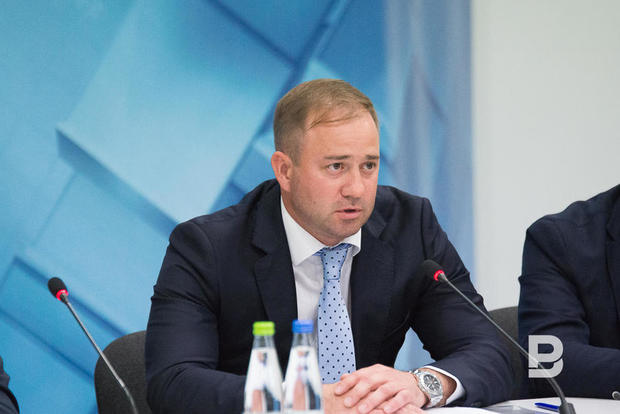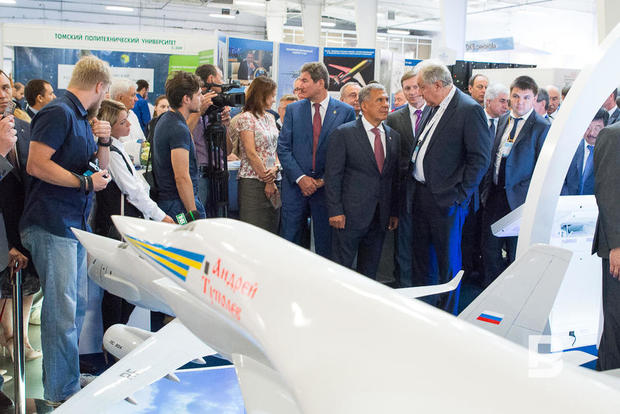Sergey Yemelyanov: Ansat will be promoted by the Sukhoi Superjet 100 pattern
Head of the Aviation Industry Department of the Ministry of Industry and Trade of the Russian Federation told Realnoe Vremya about upcoming changes in the industry
The Russian aviation industry, which has been almost a 'sacral shrine' in recent years, completely depleted remaining resources by 2016 and is going to transform into an industrial cooperation as it is customary in European aviation companies. The Ministry of Industry and Trade of the Russian Federation thinks it is necessary to get rid of the Soviet principle when every factory produces a specific type of aircraft. The Ministry is preparing enterprises to participate in a big cooperation near regional Sukhoi Superjet 100 and mid-range MC-21. The director of the Aviation Industry Department of the Ministry of Industry and Trade of the Russian Federation Sergey Yemelyanov told Realnoe Vremya why a duty-free import of used foreign planes should be banned, how the Russian authority is going to promote a Tatar lightweight helicopter called Ansat and that main concern of Gorbunov Aviation Factory now. The meeting took place on Aerospace Technologies, Modern Materials and Equipment international specialised exhibition that took place in Kazan.
Duty-free import of used vehicles will be banned for the sake of the Sukhoi Superjet 100 and the МС-21
Mr Yemelyanov, the Ministry of Industry and Trade of the Russian Federation initiated the support of the Russian aviation industry by means of a ban imposed on duty-free import of planes that have been used for more than 8 years to Russia. The response to it was mixed. Why are bans imposed on '8-year-old' vehicles?
The final decision on this topic will be discussed on 25 August at a meeting with the vice-PM of Russia Arkady Dvorkovich. We sent him our initiatives in detail (Editor's Note: the measure is taken as an expansion of a document of the Customs Union about a Temporary Duty- and Tax-Free Import of Mid-Range Airbus 319/320/321 and Boeing 737 for 170-219 seats and turboprops till 2023-2029). The restrictions will be applied to 8-year-old vehicles because a new big MC-21 plane is going to be produced by 2019-2020. Now we are creating all conditions in order to be free from any creation of mechanisms for the competitiveness of the liner, compared to used Boeing, in the operation lease market in the future. It is the logics of our actions. This problem was not discussed together with the specialists from the Ministry of Transport of Russia. And we came to an agreement on this question during several meetings. But it is also necessary to consult and explain additionally in the Government why we speak about 8 years, not 12.

'The restrictions will be applied to 8-year-old vehicles because a new big MC-21 plane is going to be produced by 2019-2020.' Photo: irkut.com
Last year the Federal Government decided to increase the authorised capital of the State Transport Lease Company PJSC in order to promote Sukhoi Superjet 100 Russian regional aircraft. Is it planned to increase the capital of the lease company this year as well?
At this moment an additional capitalisation equal to 30bn rubles has been planned within the scope of the anti-crisis plan. It has been included in the plan. It turned out it is a more effective measure. Last year it allowed to contract 32 vehicles of Sukhoi Superjet 100 right for regional flights. I mean the regional aviation, not export. The main idea in this work is to make lease payments of Sukhoi Superjet 100 comparable with the size of the lease payment for the used vehicles – for the 8-year-old Boeing and Airbus. Due to that the State Transport Lease Company signed lease contracts for 32 planes of Sukhoi Superjet 100 for regional airlines like Yamal, Orenburg Airlines. This year it is supposed to sign contracts for 32 vehicles more. At the same time the financing is meant to be both a payment to the authorised capital and taking out the money of the very State Transport Lease Company. These two sources make the lease interest rate lower. It allows the State Transport Lease Company to make leasing competitive.

The main idea in this work is to make lease payments of the Sukhoi Superjet 100 comparable with the size of the lease payment for used vehicles – for the 8-year-old Boeing and Airbus
Ansat will be promoted by the Sukhoi Superjet 100 sales pattern
This year an additional emission of shares of the Kazan Helicopter Factory by 24,8bn rubles has been registered. Who will buy it out?
First of all, the Kazan Helicopter Factory participated in many federal targeted programmes. And financing of the federal targeted programmes, as a rule, presupposes state investments in exchange for shares. It is one part. The second part will be sold within the scope of corporate procedures of Rostec…
What projects of the Kazan Helicopter Factory the state is going to invest in?
To start with, in reconstruction and rearmament of the very enterprise, further financing of the construction of the heavy Mi-38 helicopter. Market launch of the lightweight Ansat helicopter and sale of the entire market potential are more topical today.
How can the state support Ansat?
In helicopter engineering, we are planning to implement the same support mechanisms that are used in aircraft building. Now people start to understand that aviation vehicles are not 'sold' on their own. It must be an integrated product that includes financial support, warranty and maintenance service. Building the distribution system of the Sukhoi Superjet 100, we got first experience – subsidisation of the interest rate for initial parking, personnel preparation and purchase of simulators. But it all was done for planes only. Taking into account the high conjecture in the domestic and exterior markets, there was not need to do it for helicopters. But now workers in helicopter engineering understand it is necessary to work in the civilian sale sector. This is why some job on the expansion of these state support measures of helicopter engineering will be done in the short run.

Market launch of the lightweight Ansat helicopter and sale of the entire market potential are more topical today.
When will they start?
I think a part of them will start this year, and the other part – next year.
Is this support give to Ansat exceptionally or does it refer to the whole sector?
The whole sector.
To start the production of Tu-160 again is the main goal for the Kazan Aviation Factory
What role is Gorbunov Aviation Factory playing?
To start the production of Tu-160 again is the main goal for the Kazan Aviation Factory. Creation of a prospective long-range aviation complex is another big project. For this reason, I think the factory will have a full load. At the same time it will continue to manufacture Tu-214s.
The МС-21 and Sukhoi Superjet 100 are basic models in the civilian aviation industry. What should other factories do then?
Actually we are not aspiring to freeze everything at once but orienting to the market conjecture. The Sukhoi Superjet 100 was just a try because there is a limited production of regional planes worldwide. The МС-21 is a big and serious competitor for world aircraft manufacturers like Boeing and Airbus. We make a large mid-range plane and cover the whole line. And the United Aviation Corporation switches to a new industrial model that presupposed a wide cooperation of all producers. We want to get rid of a principle when every factory produced a specific type of aircraft. Every factory has its own aerodrome. We want to build a global cooperation in this project. It should be understood that the МС-21, the Sukhoi Superjet 100 and the Tu-214 are produced by the United Aviation Corporation, and there will be enough room for all enterprises.

To start the production of Tu-160 again is the main goal for the Kazan Aviation Factory. Creation of a prospective long-range aviation complex is another big project.
For example, aviation engine will be manufactured in the Perm factory, but a part of the cooperation will be located in Rybinsk and Samara. The work on large planes will be done according to this principle. Yes, the production of the Tu-204 is being conserved in Aviastar-SP in Ulyanovsk. The decision has not been taken yet, though it is planned. But actually it all depends on the demand of airlines and market carriers. We don't aim to overload one enterprise by means of the others. Last year the United Aviation Corporation produced 159 planes, only 22 of them are civilian.
What other areas will the Kazan factory develop if it is focused on long-range aviation?
At the moment only a special version of the Tu-214 is produced. This is why the enterprises are likely to have work in the next 5-6 years. Anyway, the start the production of the Tu-160 again remains the main goal.